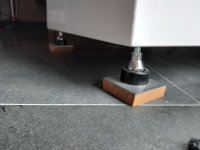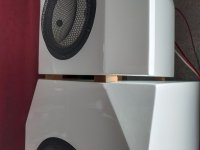Bike inner tube, you might be able to get one for a 16 inch wheel, if you need it smaller mobility scooters would be the place to look. The only advantages air has it at high speed, which I can't see as being a problem; your speakers aren't accelerating like the valves of an F1 engine.
hi thank you for the very valuable hint about scooters
another weird idea A gym weight on rubber footers above the sub with the top speaker secured to the weight with a ratchet strap
the inertia of the weight will become the inertia of the speaker
another weird idea A gym weight on rubber footers above the sub with the top speaker secured to the weight with a ratchet strap
the inertia of the weight will become the inertia of the speaker
I am curious...why are you putting the speaker on top of the sub to begin with thus creating a situation that you are looking to ameliorate ?
Why not make a stand independent of the sub and over top of it and placing the speaker on that ?
Why not make a stand independent of the sub and over top of it and placing the speaker on that ?
Sand. It’s messy, but very effective at killing vibrations in bass cabinets.
EDIT: Try sand bags.
EDIT: Try sand bags.
Last edited:
Hi you are more than rightI am curious...why are you putting the speaker on top of the sub to begin with thus creating a situation that you are looking to ameliorate ?
Why not make a stand independent of the sub and over top of it and placing the speaker on that ?
But it happens that my reference speakers use this arrangement
And they're excellent
For sure it's very convenient
I am willing to stiffen and add weights to get a decent performance
I have also little space around the speakers
For this I want to avoid side and back emissions
Only front direct sound
Like the reference speakers mentioned above
I used Sylomer in my speakers to decouple the mid-high cabinet from the bass cabinet and that one from the floor.
So that the most obstructive bass vibrations doesn't reach the mid/high
Sylomer is one of the best vibration isolation materials.
It's is a high quality polyurethane foam
I use it for all vibration absorbing: speakers, amplifiers, transformers, ...
It's 100% safe for wood, it leaves no marks and is stable in time.
It comes in 10 different stiffness/load
For my speakers I used the brown SR110 that works optimal with a pressure of 0.7kg/cm²
For 70kg(one speaker) in SR110(0.7kg/cm²) I used 100cm², that are 4 pads SR110 of 5x5cm for each speaker.
So that the most obstructive bass vibrations doesn't reach the mid/high
Sylomer is one of the best vibration isolation materials.
It's is a high quality polyurethane foam
I use it for all vibration absorbing: speakers, amplifiers, transformers, ...
It's 100% safe for wood, it leaves no marks and is stable in time.
It comes in 10 different stiffness/load
For my speakers I used the brown SR110 that works optimal with a pressure of 0.7kg/cm²
For 70kg(one speaker) in SR110(0.7kg/cm²) I used 100cm², that are 4 pads SR110 of 5x5cm for each speaker.
Attachments
An idea, you could think to try with the plastic bags dedicated to pumps to create the vacuum and then just creating vacuum. 🙂I have only to find a way to seal it with some plastic maybe
Interesting material, and my loudspeakers have the Soundcare Superspikes too. 🙂Sylomer is one of the best vibration isolation materials.
Although in my experience/opinion a decoupling related to floor loudspeakers is not the best, maybe.
If it doesn't cost too much it would be worth a try since the result is not predictable.
That also works well. But bags filled with sand under the speaker will do a good job of decoupling the speaker and woofer.To add mass I still prefer lead sheets
Good luck with the project and please let us know what are your results.
Hi ! thank you very much for your kind and very helpful advice I will look for itI used Sylomer in my speakers to decouple the mid-high cabinet from the bass cabinet and that one from the floor.
So that the most obstructive bass vibrations doesn't reach the mid/high
Sylomer is one of the best vibration isolation materials.
It's is a high quality polyurethane foam
I use it for all vibration absorbing: speakers, amplifiers, transformers, ...
It's 100% safe for wood, it leaves no marks and is stable in time.
It comes in 10 different stiffness/load
i have found a very nice video about it
actually there are many videos very interesting
i guess it must be very expensive ?
wow 70kg ? 😵 my bass cabinet will be around 20kg max Maybe a little more if i select big magnet new woofers I would use a 10-12" unitFor my speakers I used the brown SR110 that works optimal with a pressure of 0.7kg/cm²
For 70kg(one speaker) in SR110(0.7kg/cm²) I used 100cm², that are 4 pads SR110 of 5x5cm for each speaker.
i would be curious to see a pic of your speaker I see an Accuton mid ?
Last edited:
thank you very much for the great idea But now that i remember the sheets were glued and secured with metallic staples to the internal side of the panelsAn idea, you could think to try with the plastic bags dedicated to pumps to create the vacuum and then just creating vacuum. 🙂
Next week i will try to make a video with an endoscope of the internals To check better where the lead is
My main issue is the woofer cabinet If i get that right is 80% of the scope
One day i would love to understand who in the industry makes the very best sub cabinets
Fwiu the mid and high frequencies are the ones that contribute more to the soundstage Actually some 2 ways with little bass have spectacular imaging abilitiesInteresting material, and my loudspeakers have the Soundcare Superspikes too. 🙂
Although in my experience/opinion a decoupling related to floor loudspeakers is not the best, maybe.
If it doesn't cost too much it would be worth a try since the result is not predictable.
So the ground floor in my case would be the bass cabinet If it shakes it could be acceptable
But it will be better that the shaking will not arrive at the sats I will do some tests If the results are bad i will look for two columns
Nice video!
Yes, Sylomer is very good.
70kg is easy: double 10" woofers, 120l, split cabinet, double front panel, bracing, voilà you're at 70kg
Here's the thread about my speaker.
Yes, Sylomer is very good.
70kg is easy: double 10" woofers, 120l, split cabinet, double front panel, bracing, voilà you're at 70kg
Here's the thread about my speaker.
Hi thanks ! really impressive and what a xover !
for the bass solution i am always looking at commercial subs Some of the very best have just one big woofer
It is almost impossible to have low fs and high sensitivity I will prefer to have low fs Like 20Hz lets say Not very common
the sats will take over from about 300Hz So any woofer should be able to get to that point
But the lower cross in a 3 ways has been always my recurrent nightmare I have never fully understood the theory behind that issue
I still think that it is important to separate the fast bass from the slow very low bass
for the bass solution i am always looking at commercial subs Some of the very best have just one big woofer
It is almost impossible to have low fs and high sensitivity I will prefer to have low fs Like 20Hz lets say Not very common
the sats will take over from about 300Hz So any woofer should be able to get to that point
But the lower cross in a 3 ways has been always my recurrent nightmare I have never fully understood the theory behind that issue
I still think that it is important to separate the fast bass from the slow very low bass
As a general rule in industry, the resonant frequency of the isolation system should be about half that of the lowest frequency you are trying to isolate. To expect a lump of rubber/sandbag/spring/squash ball 'isolator' to effectively cover 30-300Hz (over 3 octaves) is expecting the impossible, but if it sounds subjectively better with such mods, then it's obviously worthwhile. Expectation bias is a powerful factor in how a system sounds to the listener/experimenter. Do remember though that most isolation mechanisms add a spring/mass element able to store energy before releasing it, so add yet another resonant system to the temporal mix!
If anyone has any measurement data for any kind of isolator this would be a good place to share it. I suspect, though, that most of the isolation 'improvements' ever suggested have never been actually tested for transmission attenuation, let alone for audible differences - they simply add to the store of snake oil and old wives' tails in our hobby...
If anyone has any measurement data for any kind of isolator this would be a good place to share it. I suspect, though, that most of the isolation 'improvements' ever suggested have never been actually tested for transmission attenuation, let alone for audible differences - they simply add to the store of snake oil and old wives' tails in our hobby...
Last edited:
An easy way to measure the effectiveness of whatever isolation you’re using is PLACE A GLASS OF WATER ON TOP AND WATCH THE RIPPLES OR LACK THEREOF. EASY PEASY.
The most objectionable frequencies are the very low seismic type frequencies 0-10 Hz and they occur in 6 directions of motion, 3 of which are rotational directions. That’s why one should design for the lowest resonant frequency he can, the mass on spring acts like a low pass mechanical filter. Thus, in order to reduce 10 Hz vibration significantly the Fr should be 2-3 HZ. The primary direction for vibrations all things being equal is the vertical direction.
- Subject matter expert
The most objectionable frequencies are the very low seismic type frequencies 0-10 Hz and they occur in 6 directions of motion, 3 of which are rotational directions. That’s why one should design for the lowest resonant frequency he can, the mass on spring acts like a low pass mechanical filter. Thus, in order to reduce 10 Hz vibration significantly the Fr should be 2-3 HZ. The primary direction for vibrations all things being equal is the vertical direction.
- Subject matter expert
Last edited:
Don't start with a cuboid then!My main issue is the woofer cabinet If i get that right is 80% of the scope
- Home
- General Interest
- Everything Else
- easy to find mechanical decoupling systems _ kind request for technical advice

